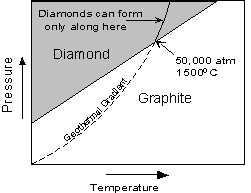
Week 11-12. Isomorphism, Polymorphism and Pseudomorphism
Polymorphism and Pseudomorphism:
There are three word ploy = many, mor= shape and phism = process,
An element or compound that can exist in more then one Crystal form is said to be polymorphous and the process that an element or compound that can change more then one crystal from this process is known as Polymorphism, which is internal structure is same and outer arrangment is different but chemical composition is same ...! Diamond and graphite is mainly composed by Carbon element but have cubic and orthorhombic respectivily.
Pseudo= false, mor= shape and phism = process,
A mineral can replaced by another mineral without any change in the external from, such replacement are called pseudomorhous and process is known as pesudomorpism. This process the cavity of mineral is present and filled with another mineral.....!
|
Polymorphism Polymorphism means "many forms". In mineralogy it means that a single chemical composition can exist with two or more different crystal structures. As we will see when we look more closely at crystal structures, if a crystal is subjected to different pressures and temperatures, the arrangement of atoms depends on the sizes of the atoms, and the sizes change with temperature and pressure. In general, as pressure increases the volume of a crystal will decrease and a point may be reached where a more compact crystal structure is more stable. The crystal structure will then change to that of the more stable structure, and a different mineral will be in existence. Similarly, if the temperature is increased, the atoms on the crystal structure will tend to vibrate more and increase their effective size. In this case, a point may be reached where a less compact crystal structure is more stable. When the crystal structure changes to the more stable structure a different mineral will form. The change that takes place between crystal structures of the same chemical compound are called polymorphic transformations. |
Pseudomorphism
Pseudomorphism is the existence of a mineral that has the appearance of another mineral. Pseudomorph means false form. Pseudomorphism occurs when a mineral is altered in such a way that its internal structure and chemical composition is changed but its external form is preserved. Three mechanisms of pseudomorphism can be defined:
- Substitution. In this mechanism chemical constituents are simultaneously removed and replaced by other chemical constituents during alteration. An example is the replacement of wood fibers by quartz to form petrified wood that has the outward appearance of the original wood, but is composed of quartz. Another example is the alteration of fluorite which forms isometric crystals and is sometimes replaced by quartz during alteration. The resulting quartz crystals look isometric, and are said to be pseudomorphed after fluorite.
- Encrustation. If during the alteration process a thin crust of a new mineral forms on the surface of a preexisting mineral, then the preexisting mineral is removed, leaving the crust behind, we say that pseudomorphism has resulted from encrustation. In this case the thin crust of the new mineral will have casts of the form of the original mineral.
- Alteration. If only partial removal of the original mineral and only partial replacement by the new mineral has taken place, then it is possible to have a the space once occupied entirely by the original mineral be partially composed of the new mineral. This results for example in serpentine pseudomorphed after olivine or pyroxene, anhydrite (CaSO4) pseudomorphed after gypsum (CaSO4.2H2O), limonite [FeO.(OH).nH2O] after pyrite (FeS2), and anglesite (PbSO4) after galena (PbS).



